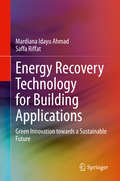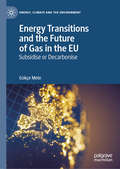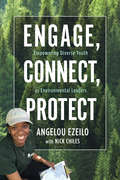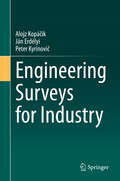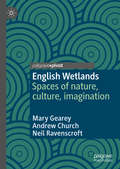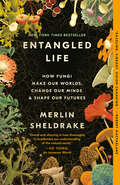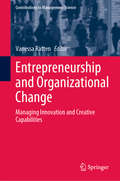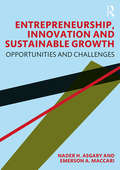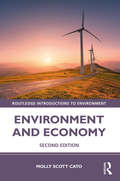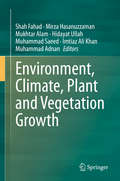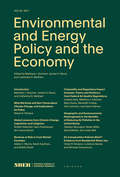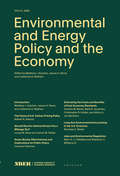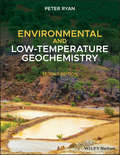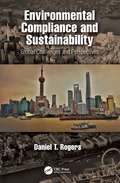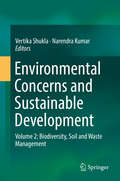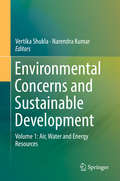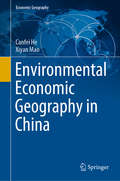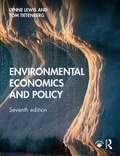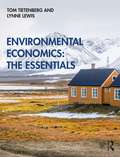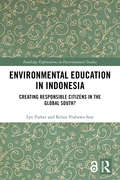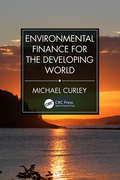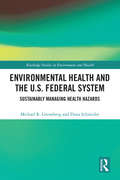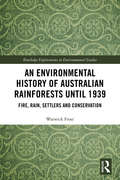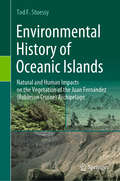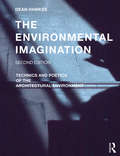- Table View
- List View
Energy Recovery Technology for Building Applications: Green Innovation towards a Sustainable Future
by Mardiana Idayu Ahmad Saffa RiffatThis book discusses energy recovery technology, a green innovation that can be used in buildings. This technology reduces energy consumption in buildings and provides energy savings to conventional mechanical ventilation systems. Divided into eight chapters, the book provides in-depth technical information, state-of-the-art research, and latest developments in the energy recovery technology field. Case-studies describe worldwide applications of energy recovery technology and its integrated system for building services. This book will be used as a general and technical reference book for students, engineers, professionals, practitioners, scientists, and researchers seeking to reduce energy consumption of buildings in various climatic conditions.Presents an overview of energy consumption scenarios in buildings and the needs for energy-efficient technologies at regional and global levels;Explains models and methods of energy recovery technology performance evaluation;Inspires further research into energy recovery technology for building applications.
Energy Transitions and the Future of Gas in the EU: Subsidise or Decarbonise (Energy, Climate and the Environment)
by Gökҫe MeteThis book assesses the impact of energy transitions on the future of natural gas in the EU energy mix. As we approach 2050, the requirement to sharply decrease CO₂ and other GHG emissions means that the role of gas infrastructure in the EU and beyond will change drastically. But what does such change mean? To address this question the author critically analyses the EU’s evolving natural gas market policy and law. Clearly structured throughout, the book explores the following questions: How can we maximise the potential of gas infrastructure to reduce carbon emissions? What are the lessons learned from decision making experience in the natural gas sector? Is the EU moving towards or away from a climate neutral gas sector? How will green and low carbon gas technologies be supported? And, are proposals to drive a growing share of hydrogen, biomethane, and synthetic methane to the system just an excuse to prolong fossil fuel operations?The book explores whether the EU will continue to subsidy natural gas projects or decarbonise the gas grid before 2050, and at what cost. Recommendations are proposed for a new regulatory and policy framework for development and operation of hydrogen pipelines, injection of biomethane into the existing gas grid and for pipelines carrying CO₂. Filling an important gap in the literature, this book aims to develop an understanding of and clarify the complex range of legislation involved within a single analytical framework. Although the focus is mainly on the future of gas in the EU, the findings and recommendations are relevant for a much wider geography. This book will be an invaluable reference to policy makers and practitioners as well as researchers and students across the social sciences interested in the future of energy.
Engage, Connect, Protect: Empowering Diverse Youth as Environmental Leaders
by Nick Chiles Angelou Ezeilo“Ezeilo artfully articulates the obscured problem of racism in the country’s environmental movement and unapologetically sets forth solutions.” —Elaine Brown, author of A Taste of PowerRevealing the deep and abiding interest that African American, Latino, and Native American communities—many of whom live in degraded and polluted parts of the country—have in our collective environment, Engage, Connect, Protect is part eye-opening critique of the cultural divide in environmentalism, part biography of a leading social entrepreneur, and part practical toolkit for engaging diverse youth. It covers:Why communities of color are largely unrecognized in the environmental movementHow to bridge the cultural divide and activate a new generation of environmental stewardsA curriculum for engaging diverse youth and young adults through culturally appropriate methods and activitiesResources for connecting mainstream America to organizations working with diverse youth within environmental projects, training, and employmentEngage, Connect, Protect is a wake-up call for businesses, activists, educators, and policymakers to recognize the work of grassroots activists in diverse communities and create opportunities for engaging with diverse youth as the next generation of environmental stewards, while the concern about the state of our land, air, and water continues to grow.“An accessible guide to respond to the inequities faced by persons of color marginalized by mainstream environmentalism.” —Dianne D. Glave, author of Rooted in the Earth“Highlights the cultural connection to nature that black and brown people have always had, and the need, for the sake of our physical, mental, and spiritual health, for it to be reclaimed.” —Kamilah Martin, Vice President at the Jane Goodall Institute
Engineering Surveys for Industry
by Alojz Kopáčik Ján Erdélyi Peter KyrinovičThis book is the translated English version of a text on industrial surveys, originally published in Slovak by SPEKTRUM STU Publishing. This updated version is not only a translation of the original, but also a reviewed, extended version, which reflects up-to-date international standards and regulations. The book covers topics in engineering surveying not available in other publications in this complex form, and addresses the design methodology, data processing and implementation of geodetic measurements under specific conditions to make industrial work environments safer and more efficient. The book begins by introducing readers to these conditions, and then discusses design of maps, geodetic networks and information systems of industrial plants, the usage of cartesian and polar coordinate measuring systems, terrestrial laser scanning technology, as well as measurement of cranes, rotary kilns and special objects of nuclear power plants. The book will be of use to teachers, students, practitioners (e.g. surveyors), quality production managers, equipment designers and mechanical engineers.
English Wetlands: Spaces of nature, culture, imagination
by Mary Gearey Andrew Church Neil RavenscroftThis book argues that to understand wetlands is to understand human development. Using case studies drawn from three English wetlands, the book moves between empirical research and scholarship to interrogate how these particular ecosystems have played an essential part in the development of our contemporary society; yet inhabit a strange place in our national psyche. Chapters address a range of cultural and environmental wetland concerns. Consideration is given to: the ways in which we have revered, engineered and renaturalised these landscapes throughout history; English wetlands as spaces of beauty, creativity, reflection, rejuvenation and multi-species interactions; accelerating climate change in an age of neoliberalism. The final chapter then is a reflection on our collective lives together alongside other species, exploring what sustainability transitions might mean for human-wetland relationships.
Entangled Life: How Fungi Make Our Worlds, Change Our Minds & Shape Our Futures
by Merlin SheldrakeA mind-bending journey into the hidden universe of fungi, &“one of those rare books that can truly change the way you see the world around you&” (Helen Macdonald, author of H Is for Hawk).&“Dazzling, vibrant, vision-changing . . . a remarkable work by a remarkable writer, which succeeds in springing life into strangeness again.&”—Robert Macfarlane, author of Underland When we think of fungi, we likely think of mushrooms. But mushrooms are only fruiting bodies, analogous to apples on a tree. Most fungi live out of sight, yet make up a massively diverse kingdom of organisms that supports and sustains nearly all living systems. Fungi provide a key to understanding the planet on which we live, and the ways we think, feel, and behave.In Entangled Life, the brilliant young biologist Merlin Sheldrake shows us the world from a fungal point of view, providing an exhilarating change of perspective. Sheldrake&’s vivid exploration takes us from yeast to psychedelics, to the fungi that range for miles underground and are the largest organisms on the planet, to those that link plants together in complex networks known as the &“Wood Wide Web,&” to those that infiltrate and manipulate insect bodies with devastating precision.Fungi throw our concepts of individuality and even intelligence into question. They are metabolic masters, earth makers, and key players in most of life&’s processes. They can change our minds, heal our bodies, and even help us remediate environmental disaster. By examining fungi on their own terms, Sheldrake reveals how these extraordinary organisms—and our relationships with them—are changing our understanding of how life works.Praise for Entangled Life&“Fungi are everywhere, and Merlin Sheldrake is an ideal guide to their mysteries. He&’s passionate, deeply knowledgeable, and a wonderful writer.&”—Elizabeth Kolbert, author of The Sixth Extinction&“I was completely unprepared for Sheldrake&’s book. It rolled me over like a tsunami, leaving the landscape rearranged but all the more beautiful.&”—Nicholas Humphrey, Emeritus Professor of Psychology at the London School of Economics and author of A History of the Mind and Soul Dust&“Sheldrake&’s charm and curiosity make for a book that is delightful to read but also grand and dizzying in how thoroughly it recalibrates our understanding of the natural world and the often overlooked organisms within it.&”—Ed Yong, author of I Contain Multitudes
Entrepreneurship and Organizational Change: Managing Innovation and Creative Capabilities (Contributions to Management Science)
by Vanessa RattenChange is a part of any organization, but in order to compete in the globally connected business environment, organizations also need to incorporate an entrepreneurial focus. This book investigates how successful organizations have intelligently responded to change by utilizing creative, innovative and dynamic solutions. Pursuing a complexity theory approach, it analyzes the changes currently taking place, and discusses the optimal use of organizational resources. This provides the reader with a more cohesive way to assess the current and potential future challenges faced by organizations as they respond to environmental, social and economic changes.
Entrepreneurship, Innovation and Sustainable Growth: Opportunities and Challenges
by Nader H. Asgary Emerson A. MaccariEntrepreneurship and innovation play a vital role in fostering sustainable development. Advances in technology and communications have both transformed the process of business as well as strengthened the role of entrepreneurship in developed and developing countries. This important book is the first to provide the fundamental concepts and applications for faculty and students in this field, and also serves as a professional reference for practicing entrepreneurs and policymakers. Each chapter provides a clear guide to the conceptual and practical elements that characterize entrepreneurship and the process of new venture formation, including functional strategies in key areas such as marketing, information technology, human resources management, and accounting and finance. Questions and exercises are presented throughout in order to encourage discussion and problem-solving. A quick summary of the important concepts and definitions are also provided. Keeping practicality as the book’s core aim, all chapters include a long case study to set the scene and then draw upon shorter cases from both developing and developed countries to reinforce key learning objectives and the real-world application of the book’s core concepts.
Environment and Economy (Routledge Introductions to Environment: Environment and Society Texts)
by Molly Scott CatoNothing is more important to our world than finding a more comfortable relationship between the economy and the environment. While issues such as species loss, nitrate pollution, water scarcity and climate change are now attracting the political attention they deserve, their origin in the way our economy is organised is less frequently recognised. This book makes that connection both theoretically – with references to a number of heterodox approaches to economics – and practically through a number of specific issues. Environment and Economy begins by introducing readers to the pioneers of this field, such as Fritz Schumacher and Paul Ehrlich, who first drew attention to the disastrous consequences for our environment of our ever-expanding economy. Part II outlines the contributions to the field of Neoclassical Economics, Environmental Economics, Ecological Economics, Green Economics and Anti-Capitalist Economics. Part III takes a pluralist approach to using economic tools to solve a range of environmental problems: economic growth, resource depletion, pollution, globalisation, climate change, markets vs. commons. Written in an accessible style, this introductory text offers students with an engaging account of the way that the various traditions of economic thought have approached the environment, bringing them together for the first time in one volume. The text is complimented by boxes, case studies and recommended reading for each theme addressed. It will be of value to students interested in environmental sciences, geography, green issues and economics.
Environment, Climate, Plant and Vegetation Growth
by Shah Fahad Mirza Hasanuzzaman Mukhtar Alam Hidayat Ullah Muhammad Saeed Imtiaz Ali Khan Muhammad AdnanThis book provides an up-to-date account of the current understanding of climate change and global warming related to environment, climate, plant and vegetation growth. The aim of this book is to provide a platform for scientists and academics world-wide to promote, share, and discuss various new issues and developments in the area of plant and vegetation growth related to climate change. Over the next decades, it is predicted that billions of people, particularly those in developing countries, face shortages of water and food and greater risks to health and life as a result of climate change. Concerted global action is needed to enable developing countries to adapt to the effects of climate change that are happening now and will worsen in the future. The book will also enhance the understanding on issues related to climate change, giving a clear indication of a looming global warming crisis. Addressing global climate change is a monumental battle that can only be fought by the leaders of tomorrow, but future leaders are molded through education and shaped by the leaders of today.
Environmental and Energy Policy and the Economy: Volume 2 (NBER-Environmental and Energy Policy and the Economy #2)
by The University of Chicago PressThis volume presents six new papers on environmental and energy economics and related policy issues. Robert Pindyck provides a systematic overview of what is known, and remains unknown, about climate change, along with the implications of uncertainty for climate policy. Shaikh Eskander, Sam Fankhauser, and Joana Setzer offer insights from a comprehensive data set on climate change legislation and litigation across all countries of the world over the past thirty years. Adele Morris, Noah Kaufman, and Siddhi Doshi shine a light on how expected trends in the coal industry will create significant challenges for the local public finance of coal-reliant communities. Joseph Aldy and his collaborators analyze the treatment of co-benefits in benefit-cost analyses of federal clean air regulations. Tatyana Deryugina and her co-authors report on the geographic and socioeconomic heterogeneity in the benefits of reducing particulate matter air pollution. Finally, Oliver Browne, Ludovica Gazze, and Michael Greenstone use detailed data on residential water consumption to evaluate the relative impacts of conservation policies based on prices, restrictions, and public persuasion.
Environmental and Energy Policy and the Economy: Volume 1 (NBER-Environmental and Energy Policy and the Economy #1)
by The University of Chicago PressThis volume presents six new papers on environmental/energy economics and policy. Robert Stavins evaluates carbon taxes versus a cap-and-trade mechanism for reducing greenhouse-gas emissions, arguing that specific design features of either instrument can be more consequential than the choice of instrument itself. Lucas Davis and James Sallee show that the exemption of electric vehicles from the gasoline tax is likely to be efficient as long as gasoline prices remain below social marginal costs, even though it results in lower tax revenue. Caroline Flammer analyzes the rapidly growing market for green bonds and highlights the importance of third-party certification to the financial and environmental performance of publically traded companies. Antonio Bento, Mark Jacobsen, Christopher Knittel, and Arthur van Benthem develop a general framework for evaluating the costs and benefits of fuel economy standards and use it to account for the differences between several recent studies of changes in these standards. Nicholas Muller estimates a measure of output in the U.S. economy over the last 60 years that accounts for air pollution damages, and shows that pollution effects are sizable, affect growth rates, and have diminished appreciably over time. Finally, Marc Hafstead and Roberton Williams illustrate methods of accounting for employment effects when evaluating the costs and benefits of environmental regulations.
Environmental and Low-Temperature Geochemistry
by Peter RyanEnvironmental and Low-Temperature Geochemistry presents conceptual and quantitative principles of geochemistry in order to foster understanding of natural processes at and near the earth’s surface, as well as anthropogenic impacts and remediation strategies. It provides the reader with principles that allow prediction of concentration, speciation, mobility and reactivity of elements and compounds in soils, waters, sediments and air, drawing attention to both thermodynamic and kinetic controls. The scope includes atmosphere, terrestrial waters, marine waters, soils, sediments and rocks in the shallow crust; the temporal scale is present to Precambrian, and the spatial scale is nanometers to local, regional and global. This second edition of Environmental and Low-Temperature Geochemistry provides the most up-to-date status of the carbon cycle and global warming, including carbon sources, sinks, fluxes and consequences, as well as emerging evidence for (and effects of) ocean acidification. Understanding environmental problems like this requires knowledge based in fundamental principles of equilibrium, kinetics, basic laws of chemistry and physics, empirical evidence, examples from the geological record, and identification of system fluxes and reservoirs that allow us to conceptualize and understand. This edition aims to do that with clear explanations of fundamental principles of geochemistry as well as information and approaches that provide the student or researcher with knowledge to address pressing questions in environmental and geological sciences. New content in this edition includes: Focus Boxes – one every two or three pages – providing case study examples (e.g. methyl isocyanate in Bhopal, origins and health effects of asbestiform minerals), concise explanations of fundamental concepts (e.g. balancing chemical equations, isotopic fractionation, using the Keq to predict reactivity), and useful information (e.g. units of concentration, titrating to determine alkalinity, measuring redox potential of natural waters); Sections on emerging contaminants for which knowledge is rapidly increasing (e.g. perfluorinated compounds, pharmaceuticals and other domestic and industrial chemicals); Greater attention to interrelationships of inorganic, organic and biotic phases and processes; Descriptions, theoretical frameworks and examples of emerging methodologies in geochemistry research, e.g. clumped C-O isotopes to assess seawater temperature over geological time, metal stable isotopes to assess source and transport processes, X-ray absorption spectroscopy to study oxidation state and valence configuration of atoms and molecules; Additional end-of-chapter problems, including more quantitatively based questions. Two detailed case studies that examine fate and transport of organic contaminants (VOCs, PFCs), with data and interpretations presented separately. These examples consider the chemical and mineralogical composition of rocks, soils and waters in the affected system; microbial influence on the decomposition of organic compounds; the effect of reduction-oxidation on transport of Fe, As and Mn; stable isotopes and synthetic compounds as tracers of flow; geological factors that influence flow; and implications for remediation. The interdisciplinary approach and range of topics – including environmental contamination of air, water and soil as well as the processes that affect both natural and anthropogenic systems – make it well-suited for environmental geochemistry courses at universities as well as liberal arts colleges.
Environmental Compliance and Sustainability: Global Challenges and Perspectives
by Daniel T. RogersThis book provides a critical understanding of the challenges that exist in protecting the local and global environment through compliance efforts using existing environmental regulations. The best compliance measures with the most useful regulations from over 50 countries are surveyed and are combined with science-based quantitative analysis of geology, hydrogeology, and the chemistry of contaminants from anthropogenic sources. The results are presented as a model that establishes a means by which protection of the environment can be greatly improved. This is accomplished through a deeper understanding of our natural world and how anthropogenic activities and their management affect our planet. Features The first book that examines the successes of environmental regulation worldwide and highlights the areas that need improvement Presents a tested and verified scientific model for enhanced environmental protection with scalability from local parcels to global levels Describes and integrates the importance of understanding the geologic and hydrogeologic environment of urban and developed areas Explains the importance of understanding the different types of pollution and their behavior in the environment Identifies the need for consistency in banning chemicals that are harmful in not just one country but throughout the world
Environmental Concerns and Sustainable Development: Volume 2: Biodiversity, Soil and Waste Management
by Vertika Shukla Narendra KumarThe current global environmental crisis is primarily the result of non-standardized parameters for environmental regulation, and is impacting e.g. clean air, safe drinking water and the quality of food, particularly in developing nations. Due to their poor/lax execution of EIA protocols, newly developing countries are preferred destinations for establishing pollution-emitting industries, which results in the degradation and depletion of their natural resources. Lack of environmental policy intervention is another major incentive to base “dirty” industries in these nations. In order to ensure sustainable development, the highest-priority issues include the monitoring and eradication of environmental problems stemming from economic development; virtually every form of economic development primarily results in the loss of forests and thus biodiversity, followed by declining air quality and the contamination of natural resources. Sustainable development ensures responsible interactions with the environment, so as to minimize the depletion or degradation of natural resources and preserve environmental quality. It involves integrated approaches to understanding the importance of environmental management systems and policy measures that lead to improved environmental performance. This book addresses the environmental concerns associated with economic development, and with approaches to attaining sustainable economic development, which include monitoring the quality of water resources, soil erosion and degradation of the natural environment.
Environmental Concerns and Sustainable Development: Volume 1: Air, Water and Energy Resources
by Vertika Shukla Narendra KumarThe prevailing global environmental crisis is primarily because of non-standardized parameters for environmental regulation. Unplanned expansion of economic activities, consideration for environmental conservation and several associated problems are emerging due to degradation in quality of ambient environment such as clean air, safe drinking water and quality of food, particularly in developing nations. Due to poor/casual execution of EIA protocol, newly developing countries are preferred destination for establishing pollution emitting industries, which results in degradation and depletion of natural resources. Lack of environmental policy intervention is another major attraction for establishing such industries in these nations. In order to ensure sustainable development, the highest priority issues include the monitoring and eradication of environmental problems which arise due to economic development. Initiation of any form of economic development primarily results in loss of forests and thus biodiversity, followed by deterioration in quality of air and contamination of natural resources. The worst impact of non-standardized economic development is the contamination of air, water and soil. Sustainable development ensures responsible interface with the environment to minimize the depletion or degradation of natural resources and ensure long term environmental quality. It involves integrated approaches in understanding the importance of environmental management systems and policy inventions leading to improved environmental performance. The present book is proposed to address the environmental concerns associated with economic development and approaches involved to attain sustainable economic development, which include monitoring of the quality of air, deforestation, quality of water resources, soil erosion and degradation of the natural environment.
Environmental Economic Geography in China (Economic Geography)
by Canfei He Xiyan MaoThis book contributes to the understanding of environment–economy relations from the perspective of economic geography, grounded in the institutional context of China. It demonstrates how classical economic geographies, new economic geographies, and geographies of economic globalization work together to affect the environment. It covers a series of classical topics like industrial location and industrial dynamics and some emerging fields like industrial evolution and global–local interaction and links them to environmental performance in China. The findings in this book echo the call for developing a more comprehensive and systematic research agenda of environmental economic geography. This book offers researchers, graduate students, and advanced undergraduate students in related fields both theoretical and practical considerations of environmental economic geography. It also offers insights into the policy-making relevant to China’s greening efforts.
Environmental Economics and Policy
by Lynne Lewis Thomas H. TietenbergEnvironmental Economics and Policy is a best-selling text for environmental economics courses. Offering a policy-oriented approach, it introduces economic theory, empirical fieldwork, and case studies that show how underlying economic principles provided the foundation for environmental policies. Key features include: Introductions to the theory and method of environmental economics, including externalities, benefit-cost analysis, valuation methods, and ecosystem goods and services. Extensive coverage of the major issues including climate change mitigation and adaptation, air and water pollution, and environmental justice. Boxed "Examples" and "Debates" throughout the text, which highlight global examples and major talking points. This text will be of use to undergraduate students of economics. Students will leave the course with a global perspective of how environmental economics has played and can continue to play a role in promoting fair and efficient environmental management. The text is fully supported with end-of-chapter summaries, discussion questions, and self-test exercises in the book. Additional online resources include references, as well as PowerPoint slides for each chapter.
Environmental Economics: The Essentials
by Tom Tietenberg Lynne LewisEnvironmental Economics: The Essentials offers a policy-oriented approach to the increasingly influential field of environmental economics that is based upon a solid foundation of economic theory and empirical research. Students will not only leave the course with a firm understanding of environmental economics, but they will also be exposed to a number of case studies showing how underlying economic principles provided the foundation for specific environmental and resource policies. This key text highlights what insights can be derived from the actual experience. Key features include: Extensive coverage of the major issues including climate change, air and water pollution, sustainable development, and environmental justice; Introductions to the theory and method of environmental economics including externalities, experimental and behavioral economics, benefit-cost analysis, and methods for valuing the services provided by the environment; Boxed ‘Examples’ and ‘Debates’ throughout the text which highlight global examples and major talking points. The text is fully supported with end-of-chapter summaries, discussion questions, and self-test exercises in the book, as well as with multiple-choice questions, simulations, references, slides, and an instructor’s manual on the Companion Website. This text is adapted from the best-selling Environmental and Natural Resource Economics, 11th edition, by the same authors.
Environmental Education in Indonesia: Creating Responsible Citizens in the Global South? (Routledge Explorations in Environmental Studies)
by Lyn Parker Kelsie Prabawa-SearIndonesia’s wealth of natural resources is being exploited at breakneck speed, and environmental awareness and knowledge among the populace is limited. This book examines how young people learn about the environment to see how education can help to develop environmental awareness and avert vast environmental destruction, not only in Indonesia, but also in the Global South more generally. Based on in-depth studies conducted in the cities of Yogyakarta and Surabaya, complemented with surveys of students in secondary schools, Environmental Education in Indonesia examines educational curricula, pedagogy and "green" activities to reveal what is currently being done in schools to educate children about the environment. The book investigates the shortcomings in environment education, including underqualified teachers, the civil service mentality, the still-pervasive chalk-and-talk pedagogy and the effect of the examination system. It also analyses the role of local government in supporting (or not) environmental education, and the contribution of environmental NGOs. The book establishes that young people are not currently being exposed to effective environmental education, and the authors propose that the best and most culturally appropriate way forward in Indonesia is to frame pro-environment behaviour and responsibility as a form of citizenship, and specifically that environmental education should be taught as a separate subject. This book will be of great interest to students and scholars of contemporary Indonesia and Southeast Asia, education for sustainability and environmental education, as well as sustainability and sustainable development more generally.
Environmental Finance for the Developing World
by Michael CurleyFinancing the Global Environment examines the financial techniques and strategies necessary to obtain funding to undertake infrastructure and environmental projects. Despite conventional notions that monies are typically not readily available for large-scale environmental projects, the book explains how this is usually not the case, and will provide the necessary steps, tools, and organizational methods necessary for successful project finance in any region. It demonstrates how the largest possible projects could be undertaken at the lowest possible cost and how a utility’s excess operating income could be used to improve the system. Features: Presents methods for the sourcing of funds and for maximizing income Defines what types of income can be used for making debt service payments and how it can be estimated Explains the basic concepts of loans and debt, as well as the present value theory of money This book serves as a useful guide for practicing professionals, industry executives, and government officials who work with water and wastewater utilities and infrastructure and are involved with financial project preparation.
Environmental Health and the U.S. Federal System: Sustainably Managing Health Hazards (Routledge Studies in Environment and Health)
by Michael R Greenberg Dona SchneiderThis book explains how the U.S. federal system manages environmental health issues, with a unique focus on risk management and human health outcomes. Building on a generic approach for understanding human health risk, this book shows how federalism has evolved in response to environmental health problems, political and ideological variations in Washington D.C, as well as in-state and local governments. It examines laws, rules and regulations, showing how they stretch or fail to adapt to environmental health challenges. Emphasis is placed on human health and safety risk and how decisions have been influenced by environmental health information. The authors review different forms of federalism, and analyse how it has had to adapt to ever evolving environmental health hazards, such as global climate change, nanomaterials, nuclear waste, fresh air and water, as well as examining the impact of robotics and artificial intelligence on worker environmental health. They demonstrate the process for assessing hazard information and the process for federalism risk management, and subsequently arguing that human health and safety should receive greater attention. This book will be essential reading for students and scholars working on environmental health and environmental policy, particularly from a public health, and risk management viewpoint, in addition to practitioners and policymakers involved in environmental management and public policy.
An Environmental History of Australian Rainforests until 1939: Fire, Rain, Settlers and Conservation (Routledge Explorations in Environmental Studies)
by Warwick FrostThis book provides a comprehensive environmental history of how Australia’s rainforests developed, the influence of Aborigines and pioneers, farmers and loggers, and of efforts to protect rainforests, to help us better understand current issues and debates surrounding their conservation and use. While interest in rainforests and the movement for their conservation are often mistakenly portrayed as features of the last few decades, the debate over human usage of rainforests stretches well back into the nineteenth century. In the modern world, rainforests are generally considered the most attractive of the ecosystems, being seen as lush, vibrant, immense, mysterious, spiritual and romantic. Rainforests hold a special place; both providing a direct link to Gondwanaland and the dinosaurs and today being the home of endangered species and highly rich in biodiversity. They are also a critical part of Australia’s heritage. Indeed, large areas of Australian rainforests are now covered by World Heritage Listing. However, they also represent a dissonant heritage. What exactly constitutes rainforest, how it should be managed and used, and how much should be protected are all issues which remain hotly contested. Debates around rainforests are particularly dominated by the contradiction of competing views and uses – seeing rainforests either as untapped resources for agriculture and forestry versus valuing and preserving them as attractive and sublime natural wonders. Australia fits into this global story as a prime example but is also of interest for its aspects that are exceptional, including the intensity of clearing at certain periods and for its place in the early development of national parks. This book will be of great interest to students and scholars of Environmental History, Australian History and Comparative History.
Environmental History of Oceanic Islands: Natural and Human Impacts on the Vegetation of the Juan Fernández (Robinson Crusoe) Archipelago
by Tod F. StuessyThe Juan Fernández Archipelago is located in the Pacific Ocean west of Chile at 33° S latitude. Robinson Crusoe Island is 667 km from the continent and approximately four million years old; Alejandro Selkirk Island is an additional 181 km west and only one million years old. The natural impacts of subsidence and erosion have shaped the landscapes of these islands, resulting in progressive changes to their subtropical vegetation. The older island has undergone more substantial changes, due to both natural causes and human impacts. After the discovery of Robinson Crusoe Island in 1574, people began cutting down forests for lumber to construct boats and homes, for firewood, and to make room for pastures. Domesticated plants and animals were introduced, some of which have since become feral or invasive, causing damage to the local vegetation. The wealth of historical records on these activities provides a detailed chronicle of how human beings use their environment for survival in a new ecosystem. This book offers an excellent case study on the impacts that people can have on the resources of an oceanic island.
The Environmental Imagination: Technics and Poetics of the Architectural Environment
by Dean HawkesThe Environmental Imagination explores the relationship between tectonics and poetics in environmental design in architecture. Working thematically and chronologically from the eighteenth century to the present day, this book redefines the historiography of environmental design by looking beyond conventional histories to argue that the environments within buildings are a collaboration between poetic intentions and technical means. In a sequence of essays, the book traces a line through works by leading architects of the nineteenth and twentieth centuries that illustrate the impact of new technologies on the conception and realisation of environments in buildings. In this, a consideration of the qualitative dimension of environment is added to the primarily technological narratives of other accounts. In this second edition, the book has been substantially rewritten and restructured to include further research conducted in the decade since the first edition. A number of important buildings have been revisited, in order to extend the descriptions of their environments, and studies have been made of a number of newly studied, significant buildings. A completely new essay offers an environmental interpretation of Luis Barragán’s magical own house in Mexico City and the earlier studies of buildings by Peter Zumthor have been gathered into a single, extended essay that includes a body of new research. On the fiftieth anniversary of the publication of Reyner Banham’s, The Architecture of the Well-tempered Environment, the book concludes with a critical tribute to that seminal text. The Environmental Imagination will appeal to academics and practitioners with interests in the history, theory and technology of architecture.
